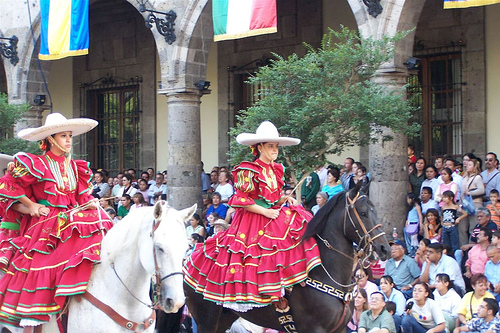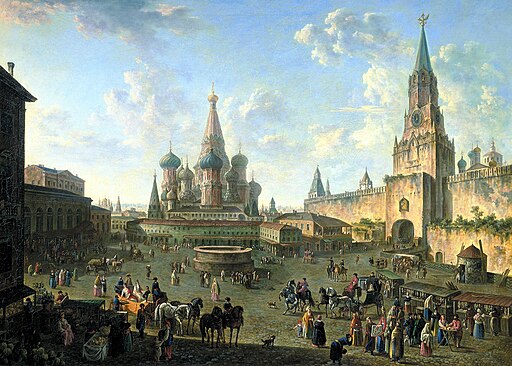
“Farmhouse in Provence” by Vincent van Gogh depicts the entrance gate to a farm with haystacks beyond the gate and with the farmhouse in the background.
When Van Gogh arrived in Arles in February 1888, the landscape was covered with snow, but it was the sun that he enjoyed in Provence. And this painting captures the brilliant light that he sought.
Van Gogh simplified the forms and reduced the scene to the flat patterns he admired in Japanese woodblock prints. Arles, he said, was:
“the Japan of the South.”
Van Gogh used pairs of complementary or contrasting, colors which together intensified the brilliance and intensity of one another’s colors:
- the orange of the farmhouse walls against the blue window and door
- the red flowers against the green plants
- the gold-green fields against the blue, lavender dividing walls
- the pink clouds against the turquoise sky.
The complementary, contrasting colors brought an intensity to his work. Van Gogh mentioned the liveliness and interplay of the colors as:
“a wedding of two complementary colors, their mingling and opposition, the mysterious vibrations of two kindred souls.”
Van Gogh had become familiar with Michel Eugène Chevreul’s laws of weaving to maximize the intensity of colors through their contrast to adjacent colors.
He used this insight to add two colors of the same degree of vividness and brightness, placed next to one another, to produce an intense visual stimulation.
Van Gogh’s time in Arles was amazingly productive. In about 444 days, he produced more than 200 paintings, about 100 drawings, and wrote more than 200 letters.
To his brother, Theo, he wrote:
“Painting … promises to become more subtle—more like music and less like sculpture—and above all, it promises color.”
At the time that Van Gogh created this painting, he was 35 years old. Living in Arles, in southern France, he was producing some of his best work, such as fields, farmhouses, and people of the Arles, Nîmes, and Avignon area.
The area was quite different from what he’d known in the Netherlands and Paris. The climate was hot and dry, and the colors were vivid. The terrain was diverse and varied from plains to mountains.
Michel Eugène Chevreul
Michel Eugène Chevreul (1786 – 1889) was a French chemist whose work influenced several areas in science, medicine, and art. His theories of color provided the scientific basis for Impressionist and Neo-Impressionist painting.
Chevreul stressed the importance of accurate portrayal of lighting in promoting realism but added:
“It is almost always so that accurate, yet exaggerated coloring is found more pleasing than absolute fidelity to the scene.”
Vincent van Gogh took this advice to heart, making lavish use of complementaries to intensify one another. Van Gogh wrote:
“This reciprocal heightening is what’s called the law of simultaneous contrast…If the complementary colors are taken at equal value, that is to say, at the same degree of brightness and light, their juxtaposition will raise both the one and the other to an intensity so violent that human eyes will scarcely be able to bear to look at it.”
Vincent van Gogh
Vincent Willem van Gogh is among the most famous and influential figures in the history of Western art. Van Gogh was unsuccessful during his lifetime and was considered a madman and a failure.
He created about 2,100 artworks, including around 860 oil paintings, most of them in the last two years of his life.
They were characterized by bold colors and dramatic, impulsive, and expressive brushwork that contributed to the foundations of modern art.
Farmhouse in Provence
- Title: Farmhouse in Provence
- Alternative: Entrance Gate to a Farm with Haystacks
- Artist: Vincent van Gogh
- Year: 1888
- Medium: Oil on canvas
- Dimensions: Height: 46.1 cm (18.1 in); Width: 60.9 cm (23.9 in)
- Museum: National Gallery of Art, Washington, D.C.
Vincent van Gogh
- Name: Vincent Willem van Gogh
- Born: 1853 – Zundert, Netherlands
- Died: 1890 (aged 37) – Auvers-Sur-Oise, France
- Resting place: Cimetière d’Auvers-Sur-Oise, Auvers-Sur-Oise, France
- Nationality: Dutch
- Movement: Post-Impressionism
- Notable works:
- Starry Night
- Starry Night Over the Rhône
- Sunflowers
- Irises (Getty Museum)
- Self Portrait, dedicated to Paul Gauguin
- Portrait of the Postman Joseph Roulin
- White House at Night
- The Night Café
- Self-Portrait as a Painter
- Self Portrait with Felt Hat
- Green Wheat Field with Cypress
- The Raising of Lazarus
- Self-Portrait Mutilated Ear
- Café Terrace at Night
- Tarascon Stagecoach
- Wheatfield with Crows
- Vase with Red Poppies
- Memory of the Garden at Etten
- Farmhouse in Provence
Farmhouse in Provence, 1888, Vincent van Gogh
Van Gogh Shadow
Retracing Van Gogh’s Footsteps in Provence
A Virtual Tour of the National Gallery of Art
- “Ginevra de’ Benci” by Leonardo da Vinci
- “A Young Girl Reading” by Jean-Honoré Fragonard
- “Small Cowper Madonna” by Raphael
- “The Alba Madonna” by Raphael
- “Nude on a Divan” by Amedeo Modigliani
- “Nude on a Blue Cushion” by Amedeo Modigliani
- “Saint Jerome” by El Greco
- “The Houses of Parliament, Sunset” by Claude Monet (National Gallery of Art, DC)
- “Breezing Up (A Fair Wind)” by Winslow Homer
- “Madame Moitessier” by Jean-Auguste-Dominique Ingres
- Adrienne (Woman with Bangs) by Amedeo Modigliani
- “Watson and the Shark” by John Singleton Copley
- “The Emperor Napoleon in His Study at the Tuileries” by Jacques-Louis David
- “The Boating Party” by Mary Cassatt
- “Interior of the Pantheon, Rome” by Giovanni Paolo Panini
- Marcelle Lender Dancing the Bolero in “Chilpéric” by Henri de Toulouse-Lautrec
- “Quadrille at the Moulin Rouge” by Henri de Toulouse-Lautrec
- “A Dutch Courtyard” by Pieter de Hooch
- “The Mother and Sister of the Artist” by Berthe Morisot
- “New York” by George Bellows
- Self-Portrait by John Singleton Copley
- “Self-Portrait” by Benjamin West
- “Symphony in White, No. 1″ by James Abbott McNeill Whistler
- A Prince of Saxony by Lucas Cranach the Elder
- A Princess of Saxony by Lucas Cranach the Elder
- “Skiffs on the Yerres” by Gustave Caillebotte
- “The Niccolini-Cowper Madonna” by Raphael
- “The Equatorial Jungle” by Henri Rousseau
- Masterpieces of the National Gallery of Art
- “Venus and Adonis” by Titian
- “Waterloo Bridge” by Claude Monet
- “Christ at the Sea of Galilee” by Circle of Tintoretto
- “Both Members of This Club” by George Bellows
- “Club Night” by George Bellows
~~~
“A wedding of two complementary colors, their mingling and opposition, the mysterious vibrations of two kindred souls.”
– Vincent van Gogh
~~~
Photo Credit: 1) Vincent van Gogh [Public domain], via Wikimedia Commons; Paul Gauguin / Public domain
Popular this Week








 Sponsor your Favorite Page
Sponsor your Favorite Page SEARCH Search for: Search Follow UsJoin – The JOM Membership Program
Sponsor a Masterpiece with YOUR NAME CHOICE for $5
Share this:
- Tweet
